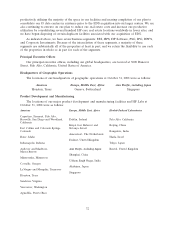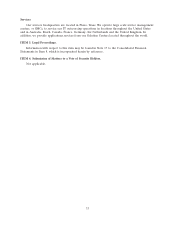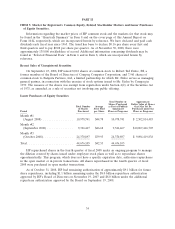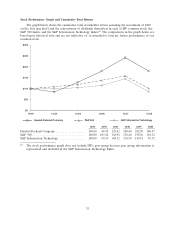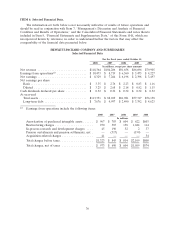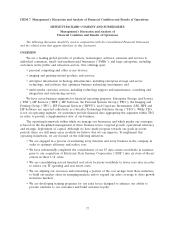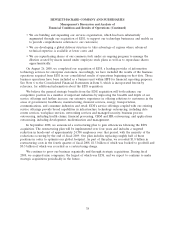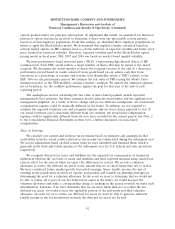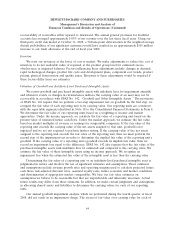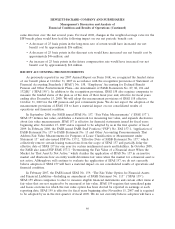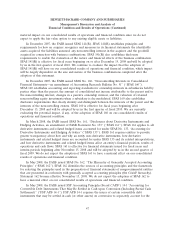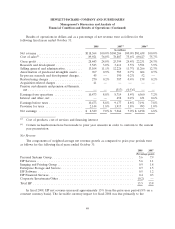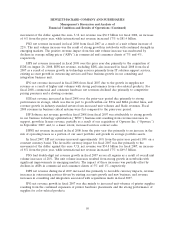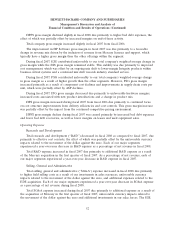HP 2008 Annual Report Download - page 48
Download and view the complete annual report
Please find page 48 of the 2008 HP annual report below. You can navigate through the pages in the report by either clicking on the pages listed below, or by using the keyword search tool below to find specific information within the annual report.HEWLETT-PACKARD COMPANY AND SUBSIDIARIES
Management’s Discussion and Analysis of
Financial Condition and Results of Operations (Continued)
options granted under our principal option plans. To implement this model, we examined our historical
pattern of option exercises in an effort to determine if there were any discernable activity patterns
based on certain employee populations. From this analysis, we identified three employee populations on
which to apply the Black-Scholes model. We determined that implied volatility calculated based on
actively traded options on HP common stock is a better indicator of expected volatility and future stock
price trends than historical volatility. Therefore, expected volatility used in the Black-Scholes option
pricing model in fiscal years 2008, 2007 and 2006 was based on market-based implied volatility.
We issue performance-based restricted units (‘‘PRUs’’) representing hypothetical shares of HP
common stock. Each PRU award reflects a target number of shares that may be issued to the award
recipient. We determine the actual number of shares the recipient receives at the end of a three-year
performance period based on results achieved versus goals based on our annual cash flow from
operations as a percentage of revenue and average total shareholder return (‘‘TSR’’) relative to the
S&P 500 over the performance period. We estimate the fair value of PRUs using the Monte Carlo
simulation model, as the TSR modifier contains a market condition. We update the estimated expense,
net of forfeitures, for the cashflow performance against the goal for that year at the end of each
reporting period.
The assumptions used in calculating the fair value of share-based payment awards represent
management’s best estimates, but these estimates involve inherent uncertainties and the application of
management judgment. As a result, if factors change and we use different assumptions, our stock-based
compensation expense could be materially different in the future. In addition, we are required to
estimate the expected forfeiture rate and recognize expense only for those shares expected to vest. If
our actual forfeiture rate is materially different from our estimate, the stock-based compensation
expense could be significantly different from what we have recorded in the current period. See Note 2
to the Consolidated Financial Statements in Item 8 for a further discussion on stock-based
compensation.
Taxes on Earnings
We calculate our current and deferred tax provisions based on estimates and assumptions that
could differ from the actual results reflected in our income tax returns filed during the subsequent year.
We record adjustments based on filed returns when we have identified and finalized them, which is
generally in the third and fourth quarters of the subsequent year for U.S. federal and state provisions,
respectively.
We recognize deferred tax assets and liabilities for the expected tax consequences of temporary
differences between the tax bases of assets and liabilities and their reported amounts using enacted tax
rates in effect for the year in which we expect the differences to reverse. We record a valuation
allowance to reduce the deferred tax assets to the amount that we are more likely than not to realize.
We have considered future market growth, forecasted earnings, future taxable income, the mix of
earnings in the jurisdictions in which we operate and prudent and feasible tax planning strategies in
determining the need for a valuation allowance. In the event we were to determine that we would not
be able to realize all or part of our net deferred tax assets in the future, we would increase the
valuation allowance and make a corresponding charge to earnings in the period in which we make such
determination. Likewise, if we later determine that we are more likely than not to realize the net
deferred tax assets, we would reverse the applicable portion of the previously provided valuation
allowance. In order for us to realize our deferred tax assets we must be able to generate sufficient
taxable income in the tax jurisdictions in which the deferred tax assets are located.
42


